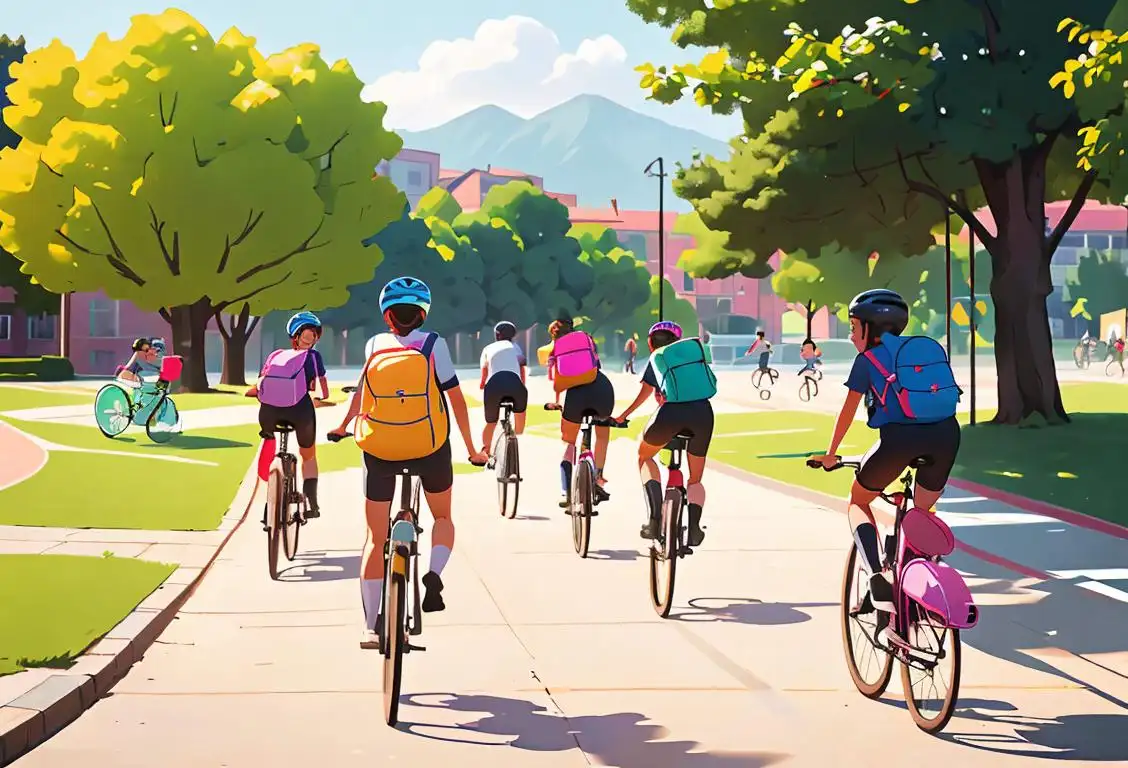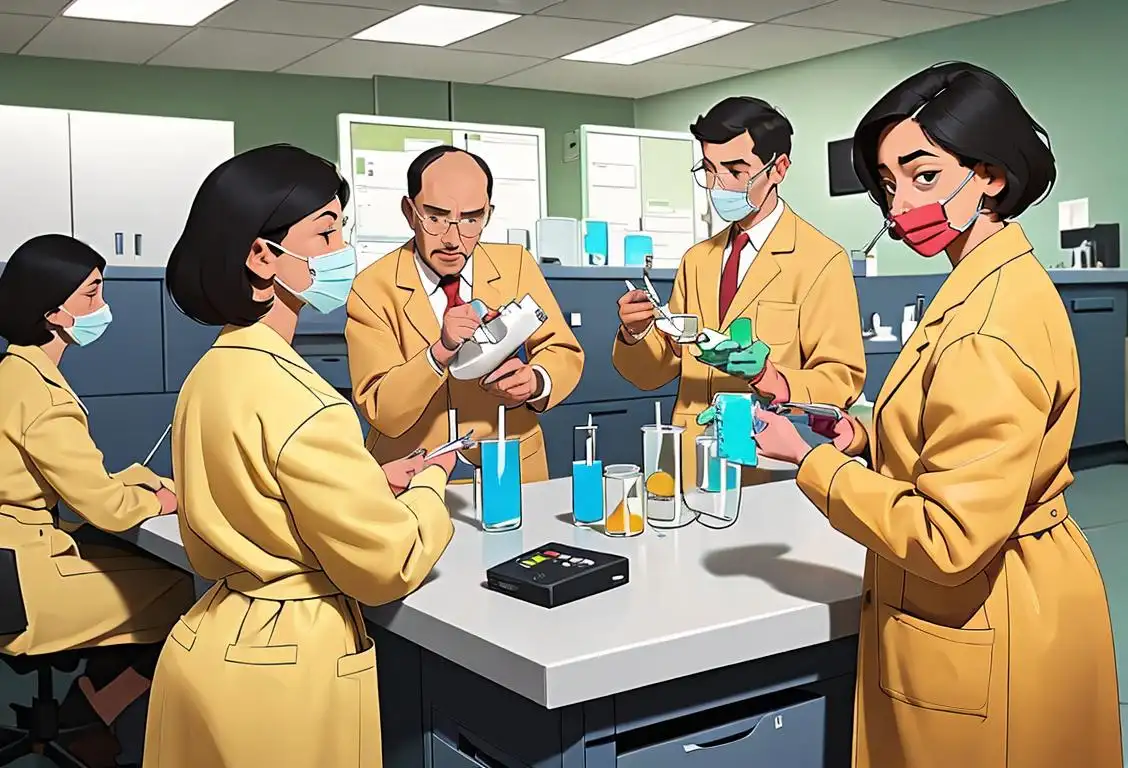National Ride To School Day

Are you ready to hop on your bicycle and pedal your way to school? It's time to celebrate National Ride to School Day! This special day encourages students to embrace the two-wheeled mode of transportation, promoting a healthy and eco-friendly way to start the day. So, dust off your trusty bike, put on your helmet, and let's explore the exciting history and significance of National Ride to School Day.
When is Ride To School Day?
It's national ride to school day on the 13th March.
The Origin of National Ride to School Day
Many years ago, some clever and environmentally conscious individuals came up with the idea of dedicating a day to raise awareness about biking to school. They wanted to encourage kids and adults alike to pedal their way to the classroom instead of relying on cars or buses. And thus, National Ride to School Day was born!
Since its inception, this national day has gained momentum and popularity. It has become a global movement, with communities around the world participating in this annual event. Schools, parents, and local organizations join forces to organize bike-centric activities, ensuring a fun-filled and educational experience for everyone involved.
The Benefits of Riding to School
Why should you consider riding your bike to school? Well, apart from the obvious health benefits of staying active, biking can also have a positive impact on the environment. By choosing pedal power over motor vehicles, you're reducing carbon emissions and doing your part to combat climate change. Plus, cycling improves cardiovascular fitness, boosts mental well-being, and enhances focus and concentration, setting you up for a successful day of learning.
How to Celebrate National Ride to School Day
Participating in National Ride to School Day is easy and fun! Here are some ideas to make the most of this special day:
- Gather your friends and classmates and organize a bike convoy to school. It's a great way to promote camaraderie and spread the message of eco-friendly transportation.
- Decorate your bikes with streamers, balloons, and colorful accessories to add a festive touch to your ride. Show off your creativity and make your bike the talk of the town!
- Host a bike safety workshop at your school. Teach fellow students about the importance of helmet usage, proper hand signals, and following traffic rules.
- Plan a bike-related scavenger hunt around your neighborhood. Explore your surroundings while solving clues and enjoying the fresh air.
Remember, safety should always be a top priority when riding your bike to school. Wear a helmet, obey traffic laws, and make sure your bike is in good working condition.
Did You Know?
A fun fact to brighten your day: Did you know that the longest tandem bike ever built measured a whopping 67 feet and could seat 35 people? Talk about a truly extraordinary biking experience!
History behind the term 'Ride To School'
1914
The Advent of Mass Education
In the early 20th century, education reform movements led to the establishment of nationwide compulsory education systems. As a result, more children were attending school, but there were challenges in getting them there. The term 'ride to school' was yet to emerge, but the concept began during this time as communities sought ways to transport children safely and efficiently.
1862
The Beginnings
In 1862, the term 'ride to school' was first used to describe the act of students traveling to school on horseback or in horse-drawn carriages. At this time, only a select few wealthy students had access to transportation to get to their educational institutions.
1897
The advent of bicycles
In 1897, the bicycle became a popular mode of transportation. This two-wheeled vehicle offered ease of mobility, allowing people to travel faster and farther than by walking. Bicycles gained popularity among individuals of all ages, including students.
1908
The Rise of Bicycles
By 1908, bicycles became more affordable and increasingly popular among the general population. This mass adoption of bicycles introduced a new way for students to ride to school. Bicycles provided a more accessible and cost-effective means of transportation, allowing a greater number of students to travel to school on their own.
1921
The School Bus Comes to Town
The first known organized effort to provide transportation for students to school can be traced back to 1921 in Wayne County, Indiana. A local banker named Wayne E. Sedgwick grew concerned about the hazards children faced walking to school, especially during harsh weather conditions. Sedgwick collaborated with the local superintendent and started a pilot program using a converted farm truck to transport students. This initiative marked the birth of the modern school bus system and laid the groundwork for the popularization of the term 'ride to school.'
1909
First school bicycle ride organized
In 1909, the first organized school bicycle ride took place, with the aim of promoting physical activity and encouraging students to ride to school. This event marked the beginning of a movement to advocate for bicycling as a healthy and sustainable mode of transport.
1920
Rise of automobile usage
During the 1920s, the popularity of automobiles soared, leading to a decline in the number of students riding bicycles to school. With the convenience and increasing affordability of cars, more families opted for motorized transportation, causing a shift away from bicycles.
1950
Widespread Adoption of School Buses
As the benefits of providing transportation to school became apparent, school districts across the United States began implementing school bus services. The use of specially designed buses with standardized routes and schedules became the norm. With more students availing themselves of this transportation, the term 'ride to school' became increasingly ingrained in the educational lexicon.
1918
The School Bus Era
In 1918, the concept of the school bus was introduced, revolutionizing the way students traveled to school. The utilization of school buses allowed for safer transportation, especially for students who lived in rural areas. This development made it possible for students who previously had to rely on walking long distances or riding animals to school, to have a more convenient and reliable mode of transportation.
1969
National Ride to School Day established
In 1969, the first National Ride to School Day was established in Australia. This annual event aimed to encourage students and their parents to ditch motorized vehicles and promote active transportation. The day involves organized group rides and serves as a reminder of the benefits of cycling to school.
1960
Expansion of School Bus Safety Standards
During the 1960s, there was a growing emphasis on ensuring the safety of students during their 'ride to school.' Various safety measures were introduced, including the requirement for school buses to be painted with bright yellow colors to enhance visibility. The significance of safe transportation further solidified the term 'ride to school' as a representation of the journey students took each day.
1960
The Automobile Era
As personal automobiles became increasingly common in the mid-20th century, 'ride to school' took on a new meaning. With more families owning cars, driving children to school became a standard practice in many communities. This era marked a shift towards individualized transportation, providing students with the convenience of door-to-door rides and reducing dependence on public transportation or school buses.
1990
Promoting Active Transportation
In the 1990s, there was a growing recognition of the importance of physical activity for children's health and well-being. This led to the promotion of 'ride to school' campaigns that encouraged students to use active modes of transportation, such as walking, biking, or skateboarding, to get to school. These initiatives aimed to reduce car dependency, improve air quality, and promote physical fitness among students.
2005
Celebrating 'Ride to School' with National Events
In recent years, 'ride to school' has gained attention as a means to promote the benefits of active transportation and raise awareness about environmental issues. Organizations and communities have started celebrating 'Ride to School Day' or similar events, encouraging students to use alternative modes of transportation like bicycles or walking. These initiatives aim to reduce traffic congestion, promote physical activity, and instill a sense of community among students. The term 'ride to school' has now become associated not only with school buses but also with sustainable transportation choices.
2006
International Walk to School Day expands
International Walk to School Day, which initially focused on promoting walking, expanded its scope to include cycling in 2006. This expansion recognized the importance of diverse sustainable transportation options, including riding bicycles to school. The event now encompasses both walking and cycling as ways to make the journey to school enjoyable and healthy.
Present
Continued efforts and initiatives
Today, various countries and organizations continue to advocate for and organize events centered around riding bicycles to school. These efforts aim to alleviate traffic congestion, reduce carbon emissions, improve physical fitness, and foster a sense of community. Riding to school has become more than a simple means of transportation; it has evolved into a movement for sustainable living and a way to promote a healthier lifestyle.
Did you know?
Did you know that the longest tandem bike ever built measured a whopping 67 feet and could seat 35 people?Tagged
awareness fun healthFirst identified
12th March 2015Most mentioned on
13th March 2020Total mentions
35Other days
Spinach Day
School Nurse Day
Lash Day
Frozen Yogurt Day
Fitness Day
Drug Test Day
Kale Day
Women Physicians Day
No Bra Day
No Smoking Day









